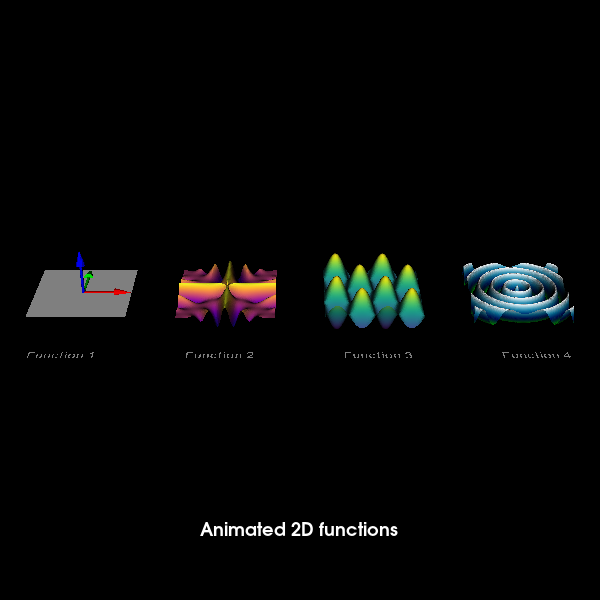Note
Go to the end to download the full example code
Animated 2D functions#
This is a simple demonstration of how one can animate 2D functions using FURY.
Importing necessary modules
import itertools
import numpy as np
import fury
The following function is used to create and update the coordinates of the points which are being used to plot the surface. It’s also used to create and update the colormap being used to color the surface. Kindly note that only the z coordinate is being modified with time as only the z coordinate is a function of time.
def update_surface(x, y, equation, cmap_name="viridis"):
# z is the function F i.e. F(x, y, t)
z = eval(equation)
xyz = np.vstack([x, y, z]).T
# creating the colormap
v = np.copy(z)
m_v = np.max(np.abs(v), axis=0)
v /= m_v if m_v else 1
colors = fury.colormap.create_colormap(v, name=cmap_name)
return xyz, colors
Variables and their usage:
- time: float
initial value of the time variable i.e. value of the time variable at the beginning of the program; (default = 0)
- dt: float
amount by which
timevariable is incremented for every iteration of timer_callback function (default = 0.1)- lower_xbound: float
- lower bound of the x values in which the function is plotted
(default = -1)
- upper_xbound: float
Upper bound of the x values in which the function is plotted (default = 1)
- lower_ybound: float
lower bound of the y values in which the function is plotted (default = -1)
- upper_ybound: float
Upper bound of the y values in which the function is plotted (default = 1)
- npoints: int
For high quality rendering, keep the number high but kindly note that higher values for npoints slows down the animation (default = 128)
time = 0
dt = 0.1
lower_xbound = -1
upper_xbound = 1
lower_ybound = -1
upper_ybound = 1
npoints = 128
creating the x, y points which will be used to fit the equation to get elevation and generate the surface
x = np.linspace(lower_xbound, upper_xbound, npoints)
y = np.linspace(lower_ybound, upper_ybound, npoints)
x, y = np.meshgrid(x, y)
x = x.reshape(-1)
y = y.reshape(-1)
Function used to create surface obtained from 2D equation.
def create_surface(x, y, equation, colormap_name):
xyz, colors = update_surface(x, y, equation=equation, cmap_name=colormap_name)
surf = fury.actor.surface(xyz, colors=colors)
surf.equation = equation
surf.cmap_name = colormap_name
surf.vertices = fury.utils.vertices_from_actor(surf)
surf.no_vertices_per_point = len(surf.vertices) / npoints**2
surf.initial_vertices = surf.vertices.copy() - np.repeat(
xyz, surf.no_vertices_per_point, axis=0
)
return surf
Equations to be plotted
eq1 = "np.abs(np.sin(x*2*np.pi*np.cos(time/2)))**1*np.cos(time/2)*\
np.abs(np.cos(y*2*np.pi*np.sin(time/2)))**1*np.sin(time/2)*1.2"
eq2 = "((x**2 - y**2)/(x**2 + y**2))**(2)*np.cos(6*np.pi*x*y-1.8*time)*0.24"
eq3 = "(np.sin(np.pi*2*x-np.sin(1.8*time))*np.cos(np.pi*2*y+np.cos(1.8*time)))\
*0.48"
eq4 = "np.cos(24*np.sqrt(x**2 + y**2) - 2*time)*0.18"
equations = [eq1, eq2, eq3, eq4]
List of colormaps to be used for the various functions.
cmap_names = ["hot", "plasma", "viridis", "ocean"]
Creating a list of surfaces.
Creating a scene object and configuring the camera’s position
scene = fury.window.Scene()
scene.set_camera(
position=(4.45, -21, 12), focal_point=(4.45, 0.0, 0.0), view_up=(0.0, 0.0, 1.0)
)
showm = fury.window.ShowManager(scene=scene, size=(600, 600))
Creating a grid to interact with surfaces individually.
# To store the function names
text = []
for i in range(4):
t_actor = fury.actor.vector_text(
text="Function " + str(i + 1), pos=(0, 0, 0), scale=(0.17, 0.2, 0.2)
)
text.append(t_actor)
grid_ui = fury.ui.GridUI(
actors=surfaces,
captions=text,
caption_offset=(-0.7, -2.5, 0),
dim=(1, 4),
cell_padding=2,
aspect_ratio=1,
rotation_axis=(0, 1, 0),
)
showm.scene.add(grid_ui)
# Adding an axes actor to the first surface.
showm.scene.add(fury.actor.axes())
Initializing text box to print the title of the animation
tb = fury.ui.TextBlock2D(bold=True, position=(200, 60))
tb.message = "Animated 2D functions"
scene.add(tb)
Initializing showm and counter
end is used to decide when to end the animation
end = 200
The 2D functions are updated and rendered here.
def timer_callback(_obj, _event):
global xyz, time
time += dt
cnt = next(counter)
# updating the colors and vertices of the triangles used to form the
# surfaces
for surf in surfaces:
xyz, colors = update_surface(
x, y, equation=surf.equation, cmap_name=surf.cmap_name
)
fury.utils.update_surface_actor_colors(surf, colors)
surf.vertices[:] = surf.initial_vertices + np.repeat(
xyz, surf.no_vertices_per_point, axis=0
)
fury.utils.update_actor(surf)
showm.render()
# to end the animation
if cnt == end:
showm.exit()
Run every 30 milliseconds
showm.add_timer_callback(True, 30, timer_callback)
interactive = False
if interactive:
showm.start()
fury.window.record(
scene=showm.scene, size=(600, 600), out_path="viz_animated_surfaces.png"
)

Total running time of the script: (0 minutes 0.426 seconds)
